Analysis of Ethical and Legal Issues in Public Health Informatics
VerifiedAdded on 2022/11/24
|9
|2693
|62
Report
AI Summary
This report examines several key aspects of public health informatics in the Australian context, focusing on ethical and legal considerations. It addresses the control, access, and management of Electronic Health Records (EHRs), highlighting the importance of balancing patient privacy with the need for data sharing among healthcare providers. The report also delves into the benefits and disadvantages of using Big Data in public health management, emphasizing the ethical challenges related to patient privacy and data transparency. Furthermore, it discusses the role of ICT for surveillance, particularly in disease outbreaks like Ebola, noting both the advantages of rapid information dissemination and the risks of spreading misinformation through social media. The concept of living labs is explored as a means of enhancing learning experiences and fostering collaboration in developing health ICT systems. Finally, the report identifies challenges in implementing ICT systems in healthcare settings, such as inadequate data storage, connectivity issues, and funding constraints, and proposes mitigation strategies. It also touches upon the use of ICT for health workforce development, citing examples of successful projects that leverage technology to improve healthcare delivery and patient outcomes. The assignment is supported by relevant references in APA style.
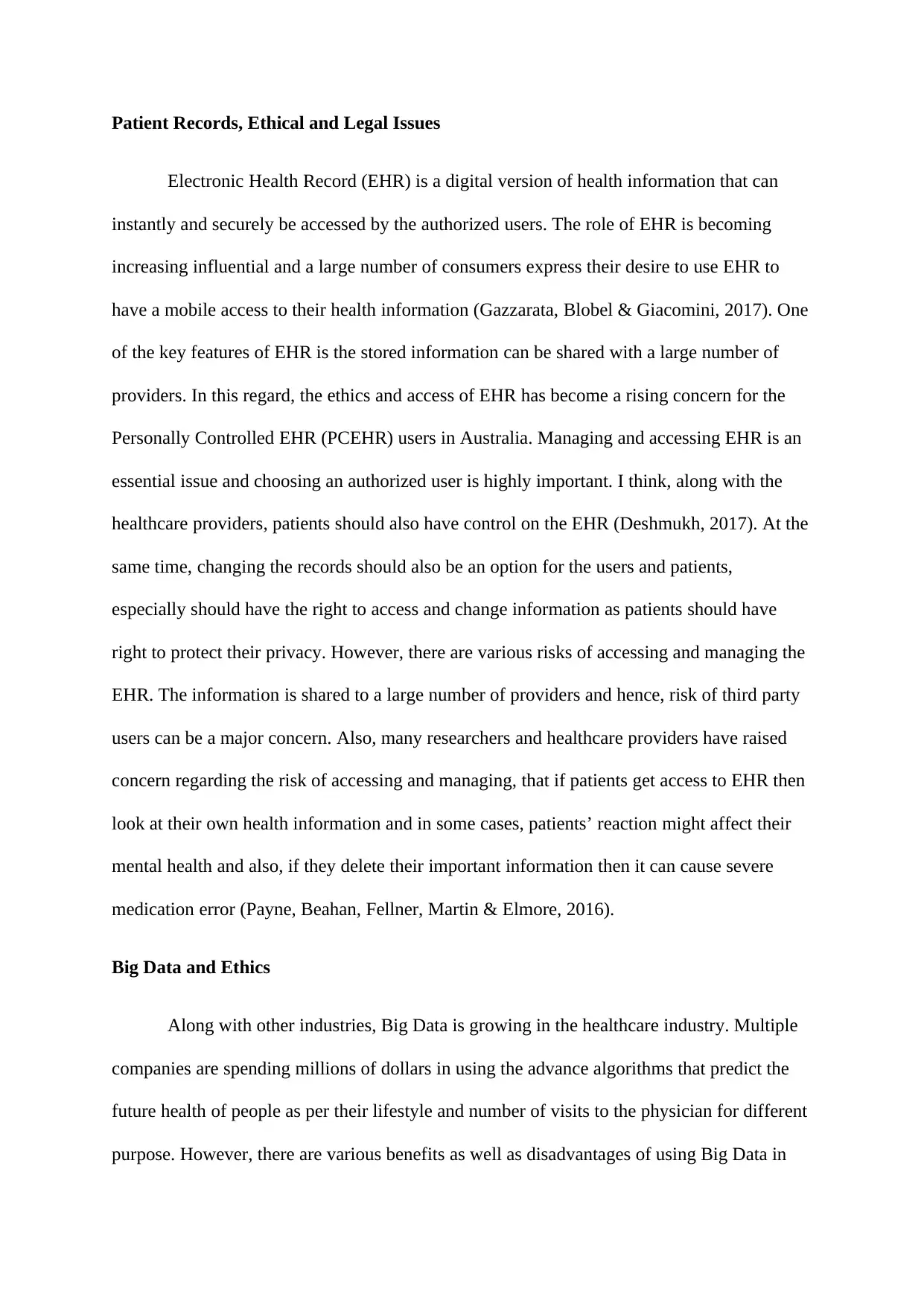
Patient Records, Ethical and Legal Issues
Electronic Health Record (EHR) is a digital version of health information that can
instantly and securely be accessed by the authorized users. The role of EHR is becoming
increasing influential and a large number of consumers express their desire to use EHR to
have a mobile access to their health information (Gazzarata, Blobel & Giacomini, 2017). One
of the key features of EHR is the stored information can be shared with a large number of
providers. In this regard, the ethics and access of EHR has become a rising concern for the
Personally Controlled EHR (PCEHR) users in Australia. Managing and accessing EHR is an
essential issue and choosing an authorized user is highly important. I think, along with the
healthcare providers, patients should also have control on the EHR (Deshmukh, 2017). At the
same time, changing the records should also be an option for the users and patients,
especially should have the right to access and change information as patients should have
right to protect their privacy. However, there are various risks of accessing and managing the
EHR. The information is shared to a large number of providers and hence, risk of third party
users can be a major concern. Also, many researchers and healthcare providers have raised
concern regarding the risk of accessing and managing, that if patients get access to EHR then
look at their own health information and in some cases, patients’ reaction might affect their
mental health and also, if they delete their important information then it can cause severe
medication error (Payne, Beahan, Fellner, Martin & Elmore, 2016).
Big Data and Ethics
Along with other industries, Big Data is growing in the healthcare industry. Multiple
companies are spending millions of dollars in using the advance algorithms that predict the
future health of people as per their lifestyle and number of visits to the physician for different
purpose. However, there are various benefits as well as disadvantages of using Big Data in
Electronic Health Record (EHR) is a digital version of health information that can
instantly and securely be accessed by the authorized users. The role of EHR is becoming
increasing influential and a large number of consumers express their desire to use EHR to
have a mobile access to their health information (Gazzarata, Blobel & Giacomini, 2017). One
of the key features of EHR is the stored information can be shared with a large number of
providers. In this regard, the ethics and access of EHR has become a rising concern for the
Personally Controlled EHR (PCEHR) users in Australia. Managing and accessing EHR is an
essential issue and choosing an authorized user is highly important. I think, along with the
healthcare providers, patients should also have control on the EHR (Deshmukh, 2017). At the
same time, changing the records should also be an option for the users and patients,
especially should have the right to access and change information as patients should have
right to protect their privacy. However, there are various risks of accessing and managing the
EHR. The information is shared to a large number of providers and hence, risk of third party
users can be a major concern. Also, many researchers and healthcare providers have raised
concern regarding the risk of accessing and managing, that if patients get access to EHR then
look at their own health information and in some cases, patients’ reaction might affect their
mental health and also, if they delete their important information then it can cause severe
medication error (Payne, Beahan, Fellner, Martin & Elmore, 2016).
Big Data and Ethics
Along with other industries, Big Data is growing in the healthcare industry. Multiple
companies are spending millions of dollars in using the advance algorithms that predict the
future health of people as per their lifestyle and number of visits to the physician for different
purpose. However, there are various benefits as well as disadvantages of using Big Data in
Paraphrase This Document
Need a fresh take? Get an instant paraphrase of this document with our AI Paraphraser
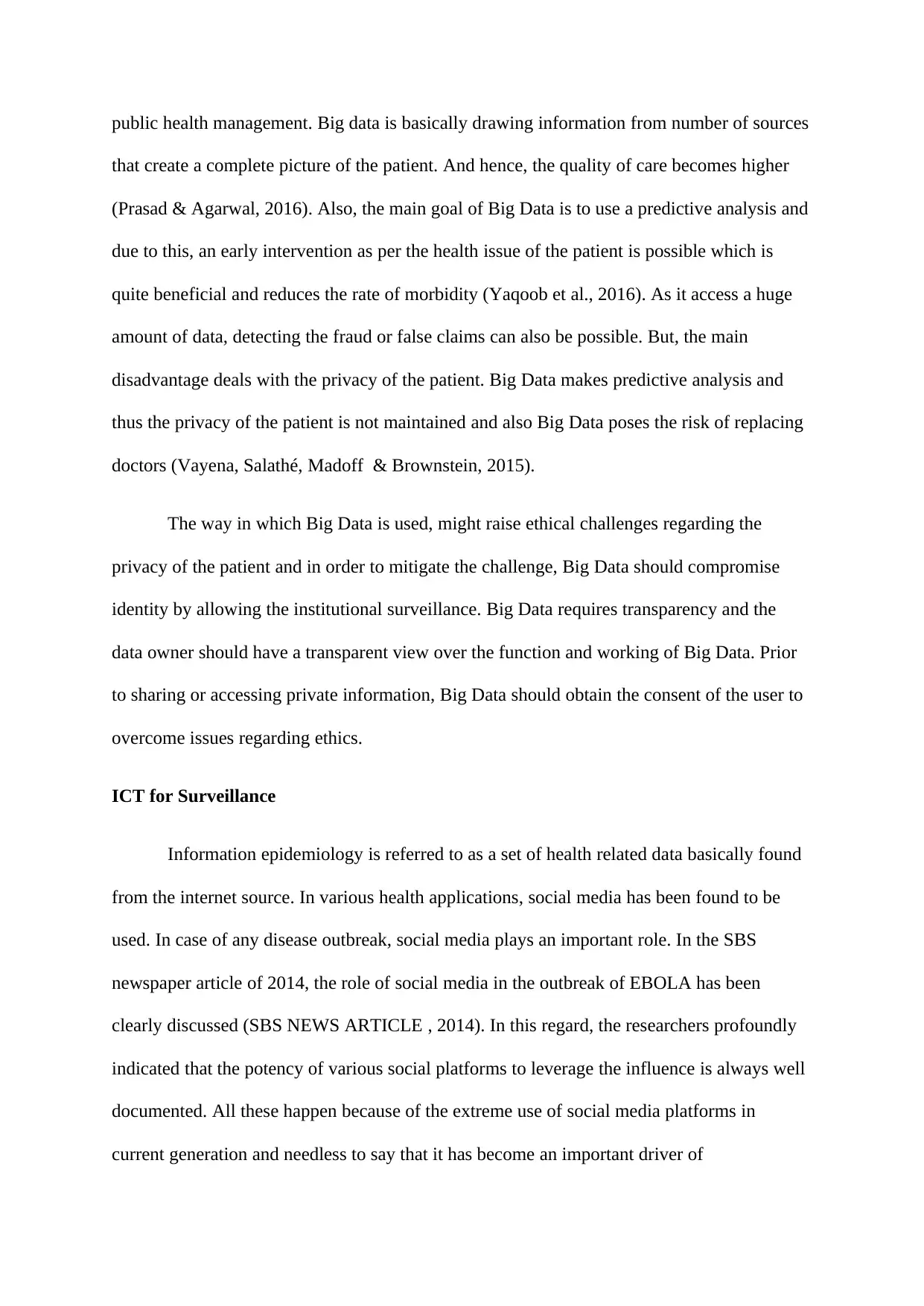
public health management. Big data is basically drawing information from number of sources
that create a complete picture of the patient. And hence, the quality of care becomes higher
(Prasad & Agarwal, 2016). Also, the main goal of Big Data is to use a predictive analysis and
due to this, an early intervention as per the health issue of the patient is possible which is
quite beneficial and reduces the rate of morbidity (Yaqoob et al., 2016). As it access a huge
amount of data, detecting the fraud or false claims can also be possible. But, the main
disadvantage deals with the privacy of the patient. Big Data makes predictive analysis and
thus the privacy of the patient is not maintained and also Big Data poses the risk of replacing
doctors (Vayena, Salathé, Madoff & Brownstein, 2015).
The way in which Big Data is used, might raise ethical challenges regarding the
privacy of the patient and in order to mitigate the challenge, Big Data should compromise
identity by allowing the institutional surveillance. Big Data requires transparency and the
data owner should have a transparent view over the function and working of Big Data. Prior
to sharing or accessing private information, Big Data should obtain the consent of the user to
overcome issues regarding ethics.
ICT for Surveillance
Information epidemiology is referred to as a set of health related data basically found
from the internet source. In various health applications, social media has been found to be
used. In case of any disease outbreak, social media plays an important role. In the SBS
newspaper article of 2014, the role of social media in the outbreak of EBOLA has been
clearly discussed (SBS NEWS ARTICLE , 2014). In this regard, the researchers profoundly
indicated that the potency of various social platforms to leverage the influence is always well
documented. All these happen because of the extreme use of social media platforms in
current generation and needless to say that it has become an important driver of
that create a complete picture of the patient. And hence, the quality of care becomes higher
(Prasad & Agarwal, 2016). Also, the main goal of Big Data is to use a predictive analysis and
due to this, an early intervention as per the health issue of the patient is possible which is
quite beneficial and reduces the rate of morbidity (Yaqoob et al., 2016). As it access a huge
amount of data, detecting the fraud or false claims can also be possible. But, the main
disadvantage deals with the privacy of the patient. Big Data makes predictive analysis and
thus the privacy of the patient is not maintained and also Big Data poses the risk of replacing
doctors (Vayena, Salathé, Madoff & Brownstein, 2015).
The way in which Big Data is used, might raise ethical challenges regarding the
privacy of the patient and in order to mitigate the challenge, Big Data should compromise
identity by allowing the institutional surveillance. Big Data requires transparency and the
data owner should have a transparent view over the function and working of Big Data. Prior
to sharing or accessing private information, Big Data should obtain the consent of the user to
overcome issues regarding ethics.
ICT for Surveillance
Information epidemiology is referred to as a set of health related data basically found
from the internet source. In various health applications, social media has been found to be
used. In case of any disease outbreak, social media plays an important role. In the SBS
newspaper article of 2014, the role of social media in the outbreak of EBOLA has been
clearly discussed (SBS NEWS ARTICLE , 2014). In this regard, the researchers profoundly
indicated that the potency of various social platforms to leverage the influence is always well
documented. All these happen because of the extreme use of social media platforms in
current generation and needless to say that it has become an important driver of
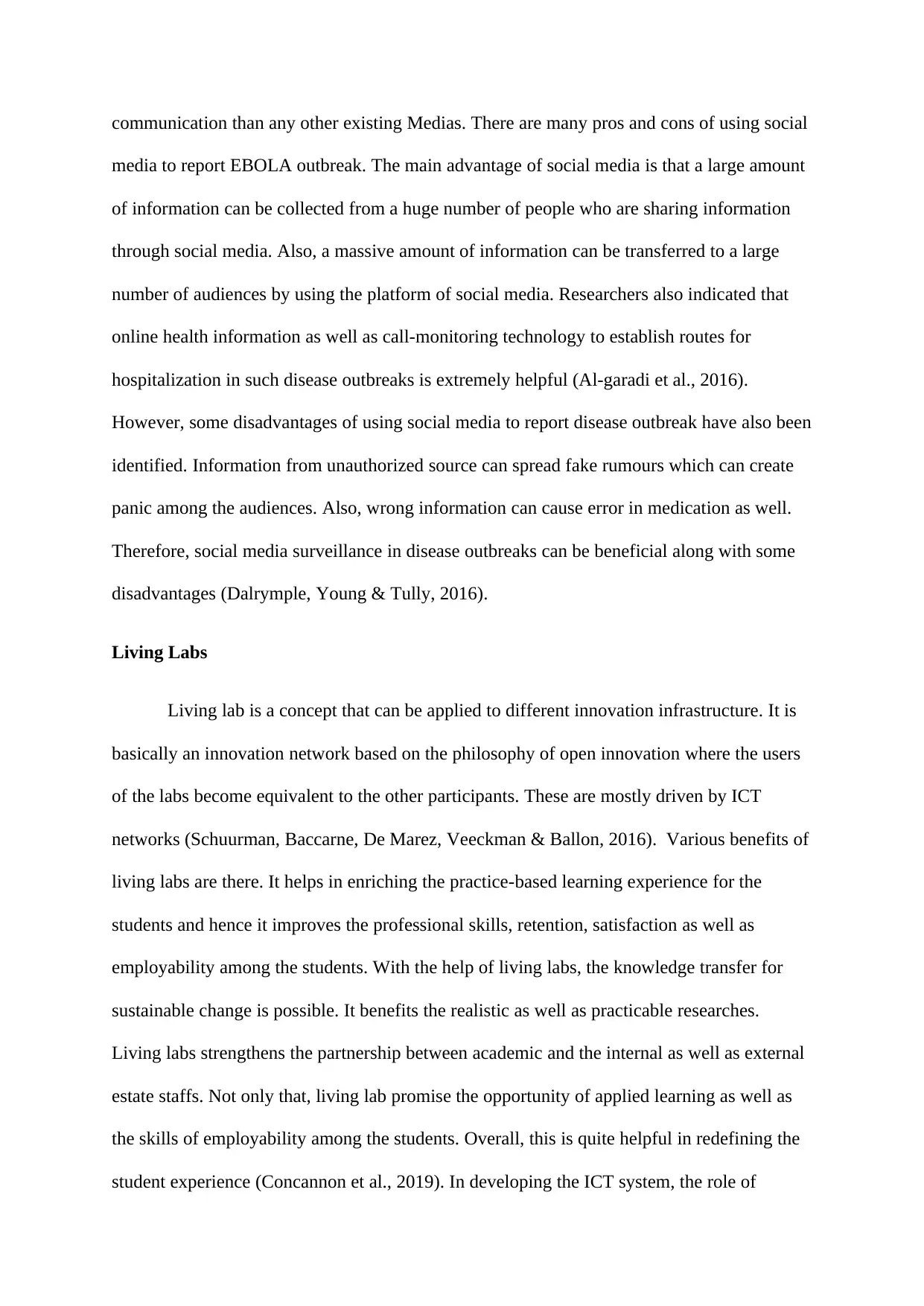
communication than any other existing Medias. There are many pros and cons of using social
media to report EBOLA outbreak. The main advantage of social media is that a large amount
of information can be collected from a huge number of people who are sharing information
through social media. Also, a massive amount of information can be transferred to a large
number of audiences by using the platform of social media. Researchers also indicated that
online health information as well as call-monitoring technology to establish routes for
hospitalization in such disease outbreaks is extremely helpful (Al-garadi et al., 2016).
However, some disadvantages of using social media to report disease outbreak have also been
identified. Information from unauthorized source can spread fake rumours which can create
panic among the audiences. Also, wrong information can cause error in medication as well.
Therefore, social media surveillance in disease outbreaks can be beneficial along with some
disadvantages (Dalrymple, Young & Tully, 2016).
Living Labs
Living lab is a concept that can be applied to different innovation infrastructure. It is
basically an innovation network based on the philosophy of open innovation where the users
of the labs become equivalent to the other participants. These are mostly driven by ICT
networks (Schuurman, Baccarne, De Marez, Veeckman & Ballon, 2016). Various benefits of
living labs are there. It helps in enriching the practice-based learning experience for the
students and hence it improves the professional skills, retention, satisfaction as well as
employability among the students. With the help of living labs, the knowledge transfer for
sustainable change is possible. It benefits the realistic as well as practicable researches.
Living labs strengthens the partnership between academic and the internal as well as external
estate staffs. Not only that, living lab promise the opportunity of applied learning as well as
the skills of employability among the students. Overall, this is quite helpful in redefining the
student experience (Concannon et al., 2019). In developing the ICT system, the role of
media to report EBOLA outbreak. The main advantage of social media is that a large amount
of information can be collected from a huge number of people who are sharing information
through social media. Also, a massive amount of information can be transferred to a large
number of audiences by using the platform of social media. Researchers also indicated that
online health information as well as call-monitoring technology to establish routes for
hospitalization in such disease outbreaks is extremely helpful (Al-garadi et al., 2016).
However, some disadvantages of using social media to report disease outbreak have also been
identified. Information from unauthorized source can spread fake rumours which can create
panic among the audiences. Also, wrong information can cause error in medication as well.
Therefore, social media surveillance in disease outbreaks can be beneficial along with some
disadvantages (Dalrymple, Young & Tully, 2016).
Living Labs
Living lab is a concept that can be applied to different innovation infrastructure. It is
basically an innovation network based on the philosophy of open innovation where the users
of the labs become equivalent to the other participants. These are mostly driven by ICT
networks (Schuurman, Baccarne, De Marez, Veeckman & Ballon, 2016). Various benefits of
living labs are there. It helps in enriching the practice-based learning experience for the
students and hence it improves the professional skills, retention, satisfaction as well as
employability among the students. With the help of living labs, the knowledge transfer for
sustainable change is possible. It benefits the realistic as well as practicable researches.
Living labs strengthens the partnership between academic and the internal as well as external
estate staffs. Not only that, living lab promise the opportunity of applied learning as well as
the skills of employability among the students. Overall, this is quite helpful in redefining the
student experience (Concannon et al., 2019). In developing the ICT system, the role of
⊘ This is a preview!⊘
Do you want full access?
Subscribe today to unlock all pages.

Trusted by 1+ million students worldwide
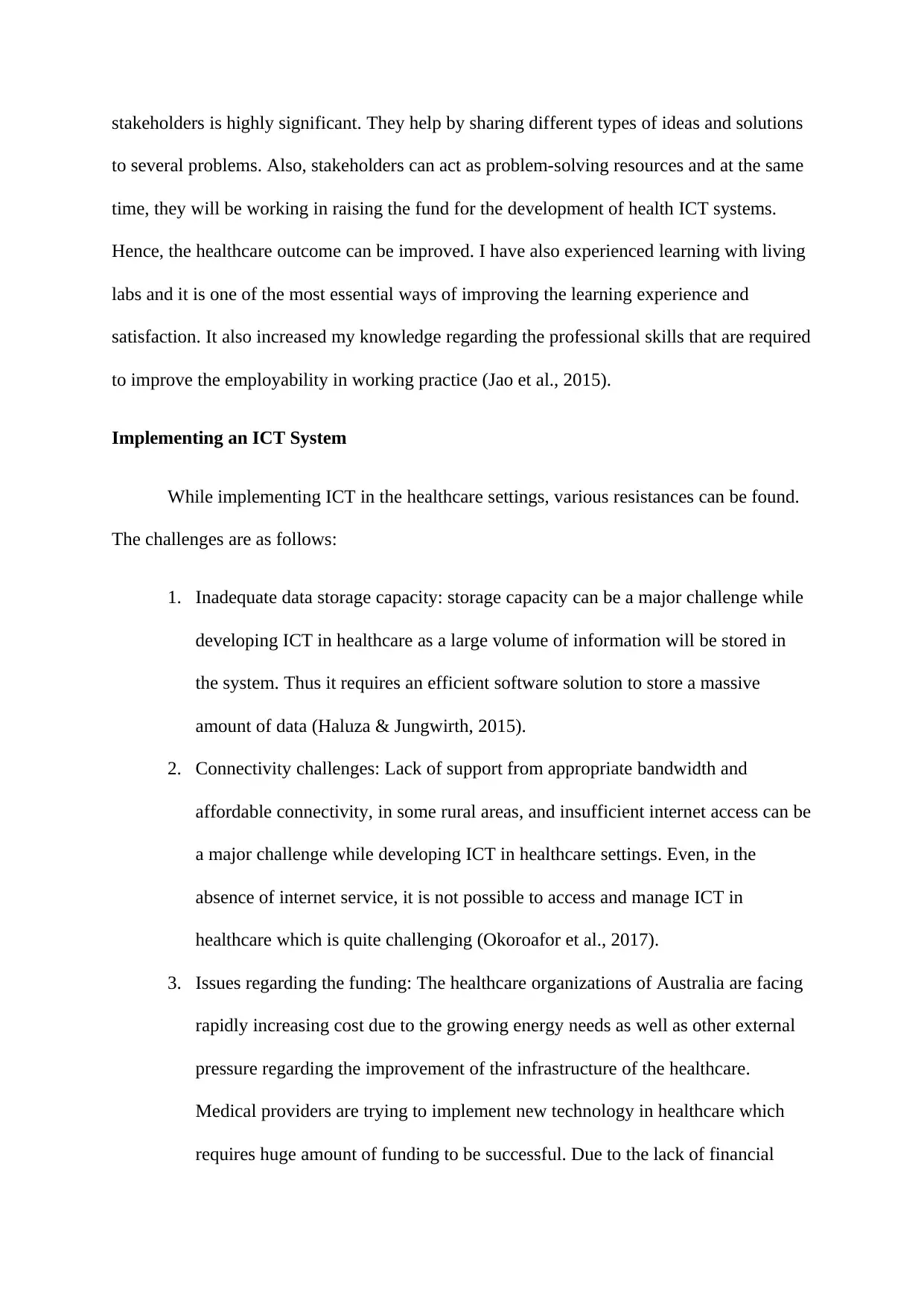
stakeholders is highly significant. They help by sharing different types of ideas and solutions
to several problems. Also, stakeholders can act as problem-solving resources and at the same
time, they will be working in raising the fund for the development of health ICT systems.
Hence, the healthcare outcome can be improved. I have also experienced learning with living
labs and it is one of the most essential ways of improving the learning experience and
satisfaction. It also increased my knowledge regarding the professional skills that are required
to improve the employability in working practice (Jao et al., 2015).
Implementing an ICT System
While implementing ICT in the healthcare settings, various resistances can be found.
The challenges are as follows:
1. Inadequate data storage capacity: storage capacity can be a major challenge while
developing ICT in healthcare as a large volume of information will be stored in
the system. Thus it requires an efficient software solution to store a massive
amount of data (Haluza & Jungwirth, 2015).
2. Connectivity challenges: Lack of support from appropriate bandwidth and
affordable connectivity, in some rural areas, and insufficient internet access can be
a major challenge while developing ICT in healthcare settings. Even, in the
absence of internet service, it is not possible to access and manage ICT in
healthcare which is quite challenging (Okoroafor et al., 2017).
3. Issues regarding the funding: The healthcare organizations of Australia are facing
rapidly increasing cost due to the growing energy needs as well as other external
pressure regarding the improvement of the infrastructure of the healthcare.
Medical providers are trying to implement new technology in healthcare which
requires huge amount of funding to be successful. Due to the lack of financial
to several problems. Also, stakeholders can act as problem-solving resources and at the same
time, they will be working in raising the fund for the development of health ICT systems.
Hence, the healthcare outcome can be improved. I have also experienced learning with living
labs and it is one of the most essential ways of improving the learning experience and
satisfaction. It also increased my knowledge regarding the professional skills that are required
to improve the employability in working practice (Jao et al., 2015).
Implementing an ICT System
While implementing ICT in the healthcare settings, various resistances can be found.
The challenges are as follows:
1. Inadequate data storage capacity: storage capacity can be a major challenge while
developing ICT in healthcare as a large volume of information will be stored in
the system. Thus it requires an efficient software solution to store a massive
amount of data (Haluza & Jungwirth, 2015).
2. Connectivity challenges: Lack of support from appropriate bandwidth and
affordable connectivity, in some rural areas, and insufficient internet access can be
a major challenge while developing ICT in healthcare settings. Even, in the
absence of internet service, it is not possible to access and manage ICT in
healthcare which is quite challenging (Okoroafor et al., 2017).
3. Issues regarding the funding: The healthcare organizations of Australia are facing
rapidly increasing cost due to the growing energy needs as well as other external
pressure regarding the improvement of the infrastructure of the healthcare.
Medical providers are trying to implement new technology in healthcare which
requires huge amount of funding to be successful. Due to the lack of financial
Paraphrase This Document
Need a fresh take? Get an instant paraphrase of this document with our AI Paraphraser
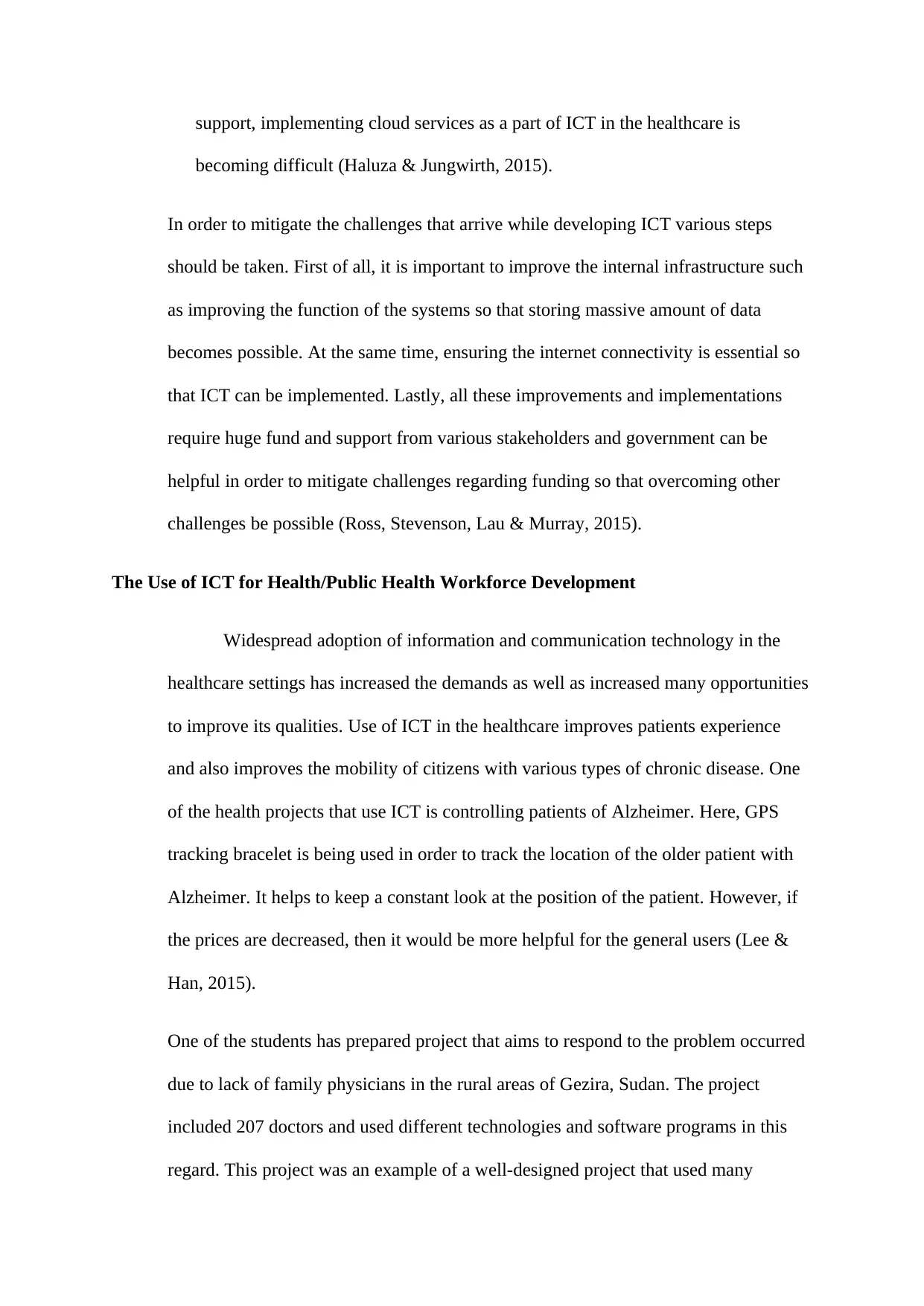
support, implementing cloud services as a part of ICT in the healthcare is
becoming difficult (Haluza & Jungwirth, 2015).
In order to mitigate the challenges that arrive while developing ICT various steps
should be taken. First of all, it is important to improve the internal infrastructure such
as improving the function of the systems so that storing massive amount of data
becomes possible. At the same time, ensuring the internet connectivity is essential so
that ICT can be implemented. Lastly, all these improvements and implementations
require huge fund and support from various stakeholders and government can be
helpful in order to mitigate challenges regarding funding so that overcoming other
challenges be possible (Ross, Stevenson, Lau & Murray, 2015).
The Use of ICT for Health/Public Health Workforce Development
Widespread adoption of information and communication technology in the
healthcare settings has increased the demands as well as increased many opportunities
to improve its qualities. Use of ICT in the healthcare improves patients experience
and also improves the mobility of citizens with various types of chronic disease. One
of the health projects that use ICT is controlling patients of Alzheimer. Here, GPS
tracking bracelet is being used in order to track the location of the older patient with
Alzheimer. It helps to keep a constant look at the position of the patient. However, if
the prices are decreased, then it would be more helpful for the general users (Lee &
Han, 2015).
One of the students has prepared project that aims to respond to the problem occurred
due to lack of family physicians in the rural areas of Gezira, Sudan. The project
included 207 doctors and used different technologies and software programs in this
regard. This project was an example of a well-designed project that used many
becoming difficult (Haluza & Jungwirth, 2015).
In order to mitigate the challenges that arrive while developing ICT various steps
should be taken. First of all, it is important to improve the internal infrastructure such
as improving the function of the systems so that storing massive amount of data
becomes possible. At the same time, ensuring the internet connectivity is essential so
that ICT can be implemented. Lastly, all these improvements and implementations
require huge fund and support from various stakeholders and government can be
helpful in order to mitigate challenges regarding funding so that overcoming other
challenges be possible (Ross, Stevenson, Lau & Murray, 2015).
The Use of ICT for Health/Public Health Workforce Development
Widespread adoption of information and communication technology in the
healthcare settings has increased the demands as well as increased many opportunities
to improve its qualities. Use of ICT in the healthcare improves patients experience
and also improves the mobility of citizens with various types of chronic disease. One
of the health projects that use ICT is controlling patients of Alzheimer. Here, GPS
tracking bracelet is being used in order to track the location of the older patient with
Alzheimer. It helps to keep a constant look at the position of the patient. However, if
the prices are decreased, then it would be more helpful for the general users (Lee &
Han, 2015).
One of the students has prepared project that aims to respond to the problem occurred
due to lack of family physicians in the rural areas of Gezira, Sudan. The project
included 207 doctors and used different technologies and software programs in this
regard. This project was an example of a well-designed project that used many
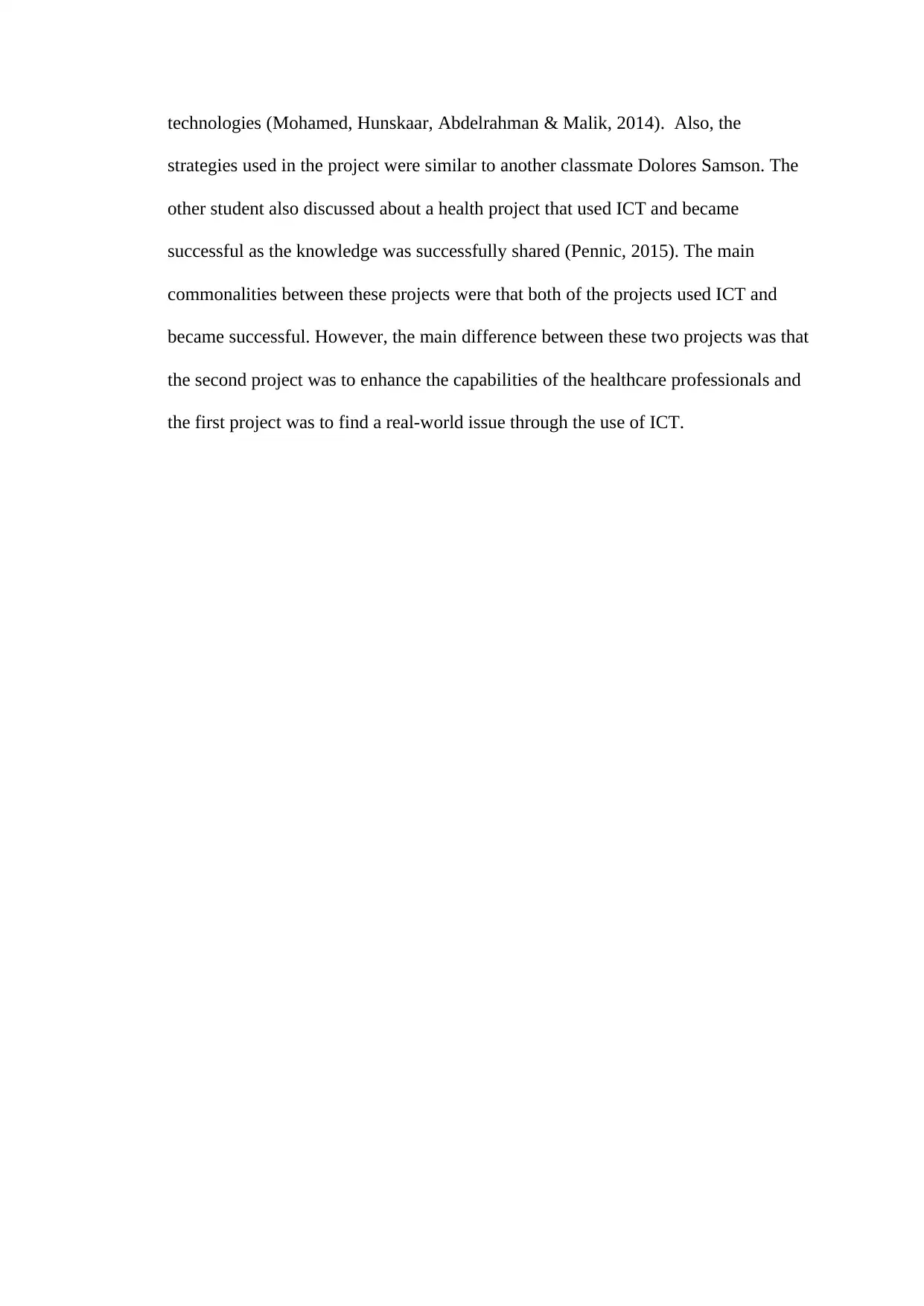
technologies (Mohamed, Hunskaar, Abdelrahman & Malik, 2014). Also, the
strategies used in the project were similar to another classmate Dolores Samson. The
other student also discussed about a health project that used ICT and became
successful as the knowledge was successfully shared (Pennic, 2015). The main
commonalities between these projects were that both of the projects used ICT and
became successful. However, the main difference between these two projects was that
the second project was to enhance the capabilities of the healthcare professionals and
the first project was to find a real-world issue through the use of ICT.
strategies used in the project were similar to another classmate Dolores Samson. The
other student also discussed about a health project that used ICT and became
successful as the knowledge was successfully shared (Pennic, 2015). The main
commonalities between these projects were that both of the projects used ICT and
became successful. However, the main difference between these two projects was that
the second project was to enhance the capabilities of the healthcare professionals and
the first project was to find a real-world issue through the use of ICT.
⊘ This is a preview!⊘
Do you want full access?
Subscribe today to unlock all pages.

Trusted by 1+ million students worldwide
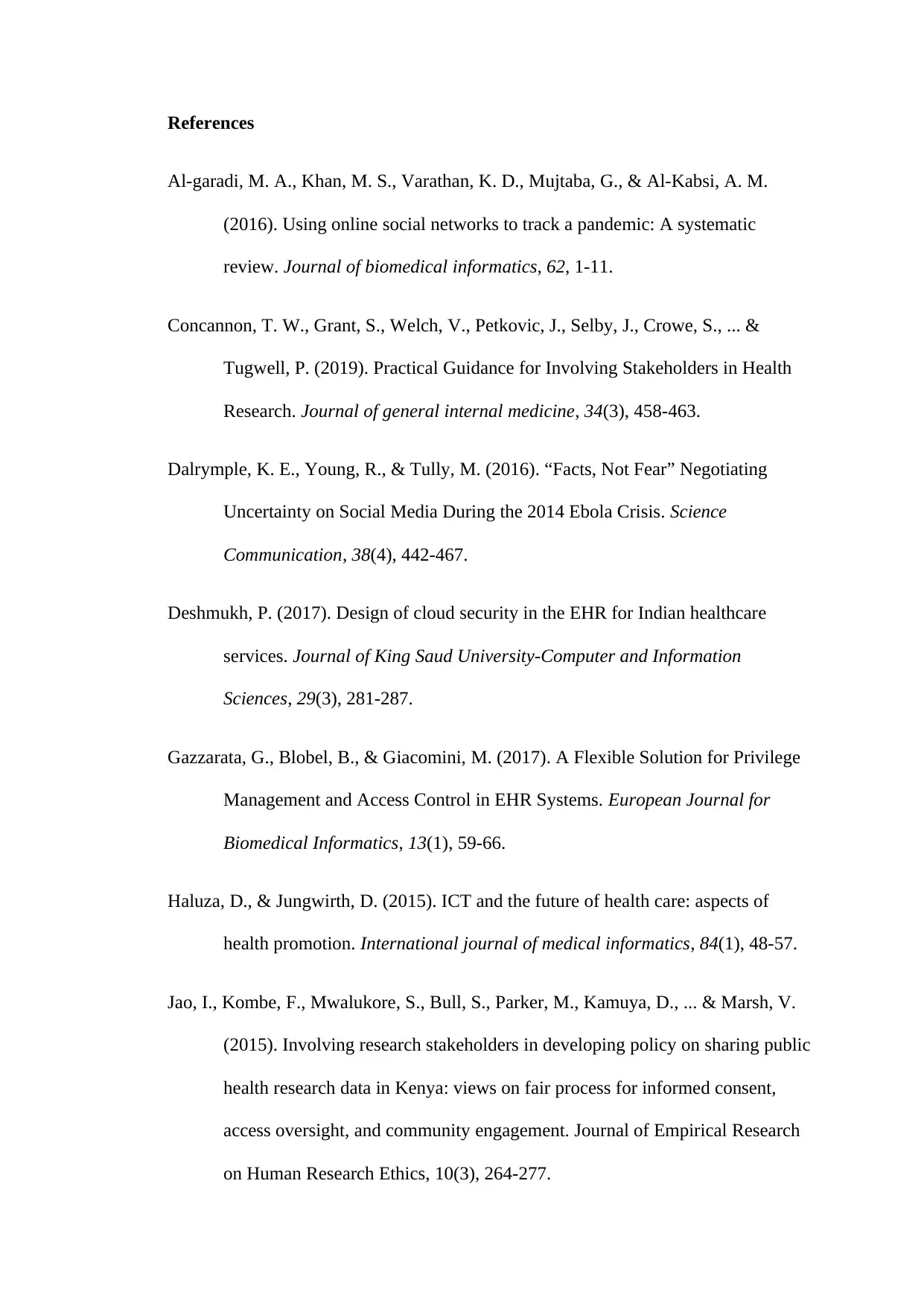
References
Al-garadi, M. A., Khan, M. S., Varathan, K. D., Mujtaba, G., & Al-Kabsi, A. M.
(2016). Using online social networks to track a pandemic: A systematic
review. Journal of biomedical informatics, 62, 1-11.
Concannon, T. W., Grant, S., Welch, V., Petkovic, J., Selby, J., Crowe, S., ... &
Tugwell, P. (2019). Practical Guidance for Involving Stakeholders in Health
Research. Journal of general internal medicine, 34(3), 458-463.
Dalrymple, K. E., Young, R., & Tully, M. (2016). “Facts, Not Fear” Negotiating
Uncertainty on Social Media During the 2014 Ebola Crisis. Science
Communication, 38(4), 442-467.
Deshmukh, P. (2017). Design of cloud security in the EHR for Indian healthcare
services. Journal of King Saud University-Computer and Information
Sciences, 29(3), 281-287.
Gazzarata, G., Blobel, B., & Giacomini, M. (2017). A Flexible Solution for Privilege
Management and Access Control in EHR Systems. European Journal for
Biomedical Informatics, 13(1), 59-66.
Haluza, D., & Jungwirth, D. (2015). ICT and the future of health care: aspects of
health promotion. International journal of medical informatics, 84(1), 48-57.
Jao, I., Kombe, F., Mwalukore, S., Bull, S., Parker, M., Kamuya, D., ... & Marsh, V.
(2015). Involving research stakeholders in developing policy on sharing public
health research data in Kenya: views on fair process for informed consent,
access oversight, and community engagement. Journal of Empirical Research
on Human Research Ethics, 10(3), 264-277.
Al-garadi, M. A., Khan, M. S., Varathan, K. D., Mujtaba, G., & Al-Kabsi, A. M.
(2016). Using online social networks to track a pandemic: A systematic
review. Journal of biomedical informatics, 62, 1-11.
Concannon, T. W., Grant, S., Welch, V., Petkovic, J., Selby, J., Crowe, S., ... &
Tugwell, P. (2019). Practical Guidance for Involving Stakeholders in Health
Research. Journal of general internal medicine, 34(3), 458-463.
Dalrymple, K. E., Young, R., & Tully, M. (2016). “Facts, Not Fear” Negotiating
Uncertainty on Social Media During the 2014 Ebola Crisis. Science
Communication, 38(4), 442-467.
Deshmukh, P. (2017). Design of cloud security in the EHR for Indian healthcare
services. Journal of King Saud University-Computer and Information
Sciences, 29(3), 281-287.
Gazzarata, G., Blobel, B., & Giacomini, M. (2017). A Flexible Solution for Privilege
Management and Access Control in EHR Systems. European Journal for
Biomedical Informatics, 13(1), 59-66.
Haluza, D., & Jungwirth, D. (2015). ICT and the future of health care: aspects of
health promotion. International journal of medical informatics, 84(1), 48-57.
Jao, I., Kombe, F., Mwalukore, S., Bull, S., Parker, M., Kamuya, D., ... & Marsh, V.
(2015). Involving research stakeholders in developing policy on sharing public
health research data in Kenya: views on fair process for informed consent,
access oversight, and community engagement. Journal of Empirical Research
on Human Research Ethics, 10(3), 264-277.
Paraphrase This Document
Need a fresh take? Get an instant paraphrase of this document with our AI Paraphraser
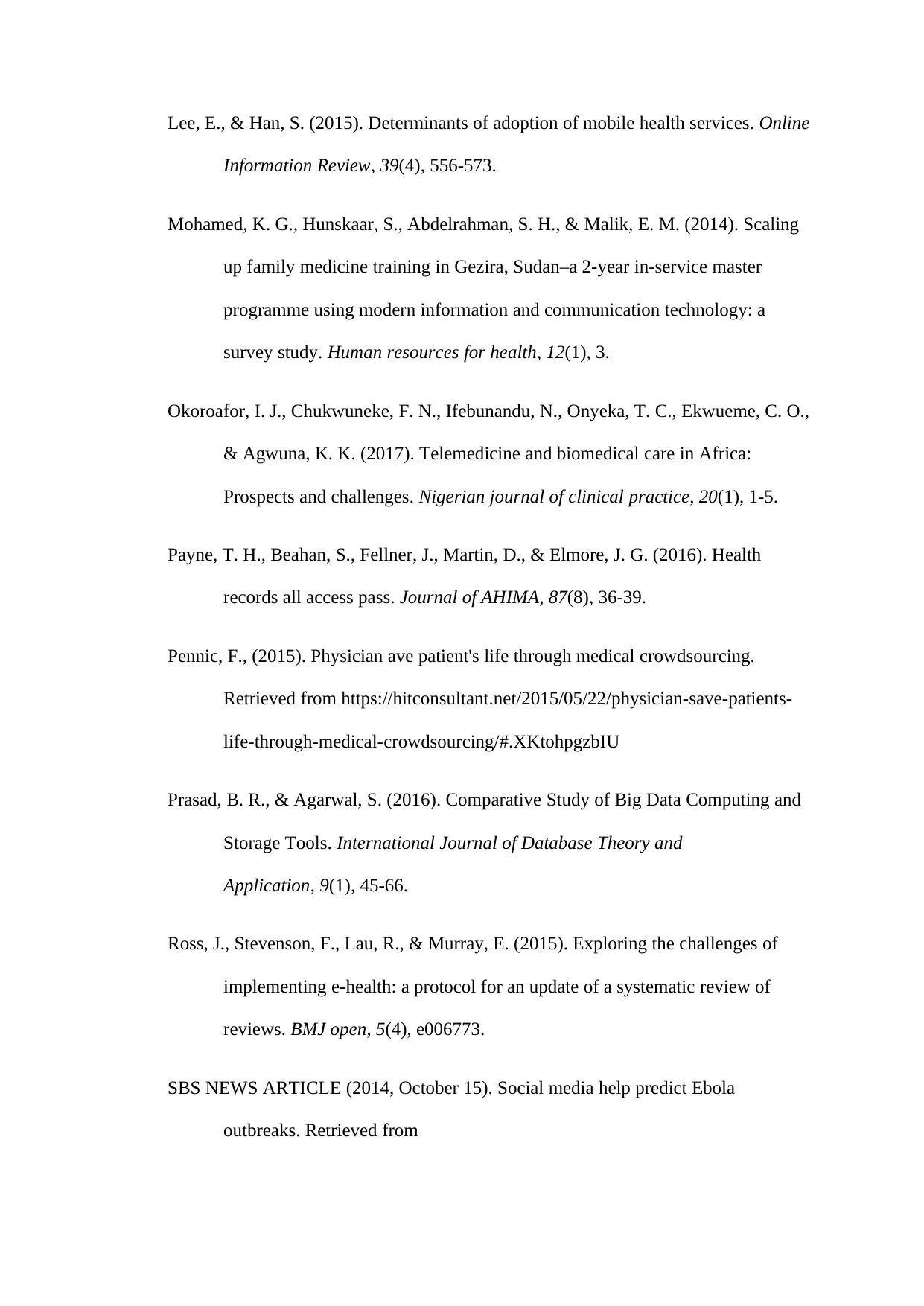
Lee, E., & Han, S. (2015). Determinants of adoption of mobile health services. Online
Information Review, 39(4), 556-573.
Mohamed, K. G., Hunskaar, S., Abdelrahman, S. H., & Malik, E. M. (2014). Scaling
up family medicine training in Gezira, Sudan–a 2-year in-service master
programme using modern information and communication technology: a
survey study. Human resources for health, 12(1), 3.
Okoroafor, I. J., Chukwuneke, F. N., Ifebunandu, N., Onyeka, T. C., Ekwueme, C. O.,
& Agwuna, K. K. (2017). Telemedicine and biomedical care in Africa:
Prospects and challenges. Nigerian journal of clinical practice, 20(1), 1-5.
Payne, T. H., Beahan, S., Fellner, J., Martin, D., & Elmore, J. G. (2016). Health
records all access pass. Journal of AHIMA, 87(8), 36-39.
Pennic, F., (2015). Physician ave patient's life through medical crowdsourcing.
Retrieved from https://hitconsultant.net/2015/05/22/physician-save-patients-
life-through-medical-crowdsourcing/#.XKtohpgzbIU
Prasad, B. R., & Agarwal, S. (2016). Comparative Study of Big Data Computing and
Storage Tools. International Journal of Database Theory and
Application, 9(1), 45-66.
Ross, J., Stevenson, F., Lau, R., & Murray, E. (2015). Exploring the challenges of
implementing e-health: a protocol for an update of a systematic review of
reviews. BMJ open, 5(4), e006773.
SBS NEWS ARTICLE (2014, October 15). Social media help predict Ebola
outbreaks. Retrieved from
Information Review, 39(4), 556-573.
Mohamed, K. G., Hunskaar, S., Abdelrahman, S. H., & Malik, E. M. (2014). Scaling
up family medicine training in Gezira, Sudan–a 2-year in-service master
programme using modern information and communication technology: a
survey study. Human resources for health, 12(1), 3.
Okoroafor, I. J., Chukwuneke, F. N., Ifebunandu, N., Onyeka, T. C., Ekwueme, C. O.,
& Agwuna, K. K. (2017). Telemedicine and biomedical care in Africa:
Prospects and challenges. Nigerian journal of clinical practice, 20(1), 1-5.
Payne, T. H., Beahan, S., Fellner, J., Martin, D., & Elmore, J. G. (2016). Health
records all access pass. Journal of AHIMA, 87(8), 36-39.
Pennic, F., (2015). Physician ave patient's life through medical crowdsourcing.
Retrieved from https://hitconsultant.net/2015/05/22/physician-save-patients-
life-through-medical-crowdsourcing/#.XKtohpgzbIU
Prasad, B. R., & Agarwal, S. (2016). Comparative Study of Big Data Computing and
Storage Tools. International Journal of Database Theory and
Application, 9(1), 45-66.
Ross, J., Stevenson, F., Lau, R., & Murray, E. (2015). Exploring the challenges of
implementing e-health: a protocol for an update of a systematic review of
reviews. BMJ open, 5(4), e006773.
SBS NEWS ARTICLE (2014, October 15). Social media help predict Ebola
outbreaks. Retrieved from
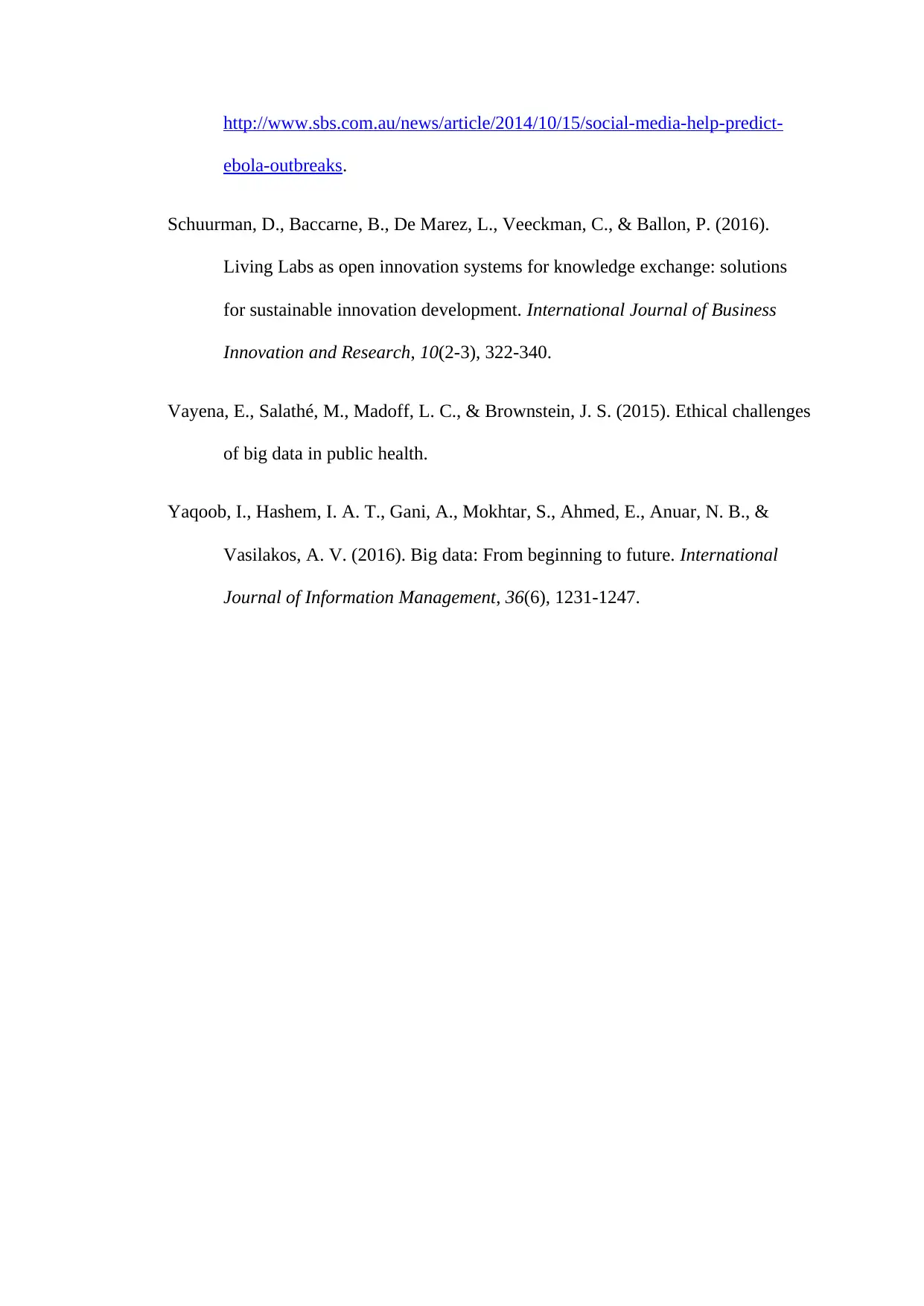
http://www.sbs.com.au/news/article/2014/10/15/social-media-help-predict-
ebola-outbreaks.
Schuurman, D., Baccarne, B., De Marez, L., Veeckman, C., & Ballon, P. (2016).
Living Labs as open innovation systems for knowledge exchange: solutions
for sustainable innovation development. International Journal of Business
Innovation and Research, 10(2-3), 322-340.
Vayena, E., Salathé, M., Madoff, L. C., & Brownstein, J. S. (2015). Ethical challenges
of big data in public health.
Yaqoob, I., Hashem, I. A. T., Gani, A., Mokhtar, S., Ahmed, E., Anuar, N. B., &
Vasilakos, A. V. (2016). Big data: From beginning to future. International
Journal of Information Management, 36(6), 1231-1247.
ebola-outbreaks.
Schuurman, D., Baccarne, B., De Marez, L., Veeckman, C., & Ballon, P. (2016).
Living Labs as open innovation systems for knowledge exchange: solutions
for sustainable innovation development. International Journal of Business
Innovation and Research, 10(2-3), 322-340.
Vayena, E., Salathé, M., Madoff, L. C., & Brownstein, J. S. (2015). Ethical challenges
of big data in public health.
Yaqoob, I., Hashem, I. A. T., Gani, A., Mokhtar, S., Ahmed, E., Anuar, N. B., &
Vasilakos, A. V. (2016). Big data: From beginning to future. International
Journal of Information Management, 36(6), 1231-1247.
⊘ This is a preview!⊘
Do you want full access?
Subscribe today to unlock all pages.

Trusted by 1+ million students worldwide
1 out of 9
Related Documents
Your All-in-One AI-Powered Toolkit for Academic Success.
+13062052269
info@desklib.com
Available 24*7 on WhatsApp / Email
![[object Object]](/_next/static/media/star-bottom.7253800d.svg)
Unlock your academic potential
Copyright © 2020–2025 A2Z Services. All Rights Reserved. Developed and managed by ZUCOL.





